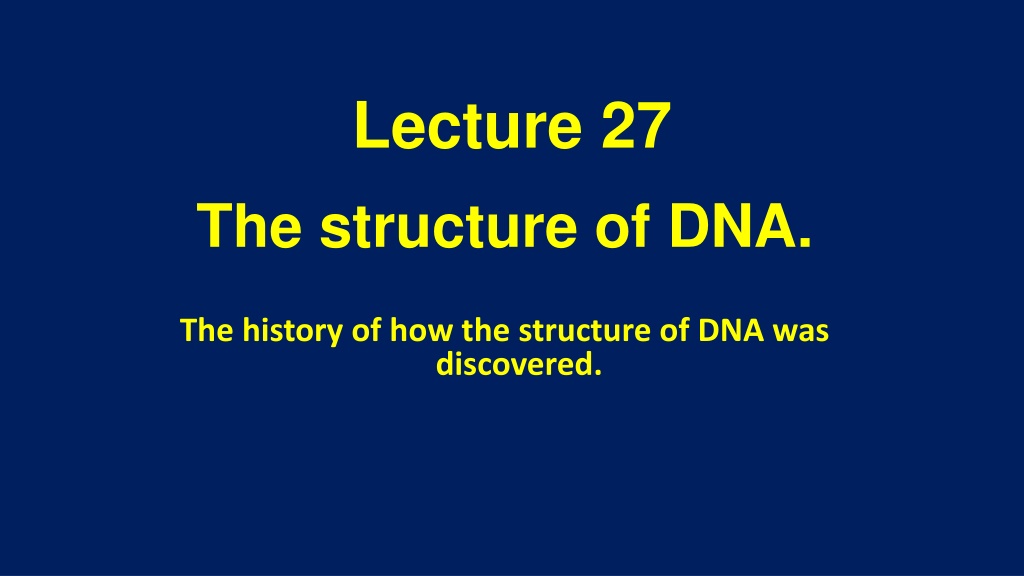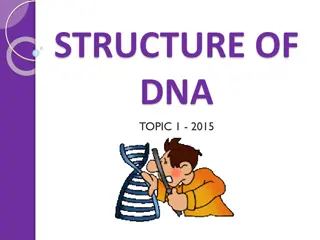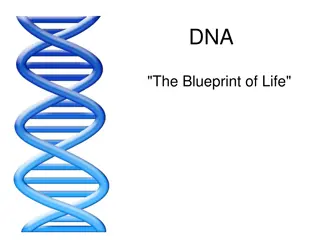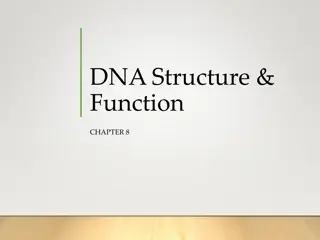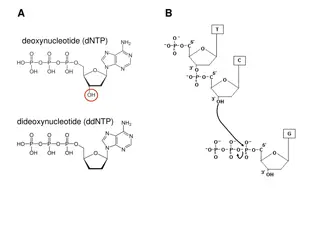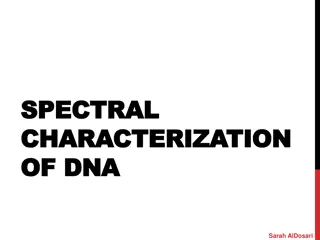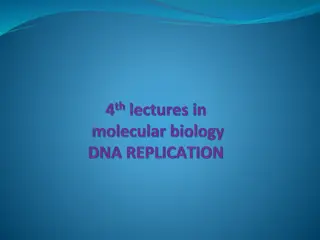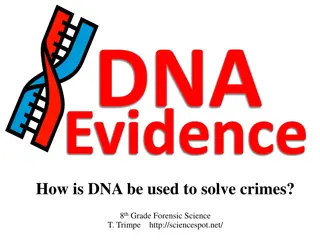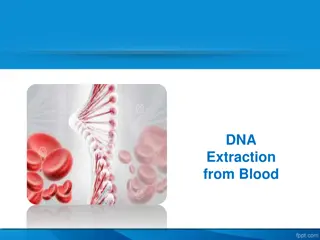The Fascinating History of DNA Structure Discovery
Delve into the historical journey of uncovering the structure of DNA, starting from Johann Friedrich Miescher's isolation of nuclein in 1869 to Phoebus Levene's identification of nucleotides in 1930. Learn about key contributors like Albrecht Kossel and the significant breakthroughs that paved the way for our understanding of DNA's composition.
Download Presentation

Please find below an Image/Link to download the presentation.
The content on the website is provided AS IS for your information and personal use only. It may not be sold, licensed, or shared on other websites without obtaining consent from the author. Download presentation by click this link. If you encounter any issues during the download, it is possible that the publisher has removed the file from their server.
E N D
Presentation Transcript
Lecture 27 The structure of DNA. The history of how the structure of DNA was discovered.
The structure of DNA: a historical approach. - - A long history with many contributors. Against the background of the DNA-or-protein debate.
Johann Friedrich Miescher (1869): discovery of nucleic acid. Swiss physician/biologist interested in the function of the nucleus of white blood cells, isolated a white precipitate distinct from the known macromolecules of the cell that he called nuclein. The material was acidic, rich in phosphoric acid and nitrogen but devoid of sulfur. He isolated the material from the pus that accumulated in bandages of infected wounds, the contents of pyometra of dogs (infected uterus of dogs with pseudo-pregnancy), and sperm of fish.
Johann Friedrich Miescher (1869): discovery of nucleic acid.
Albrecht Kossel (1881): Identification of N-containing bases. German biochemist working in the same lab as Miescher followed up on the white powder of Miescher and identified the presence of the n- containing bases: adenine, guanine, cytosine, thymine, and uracyl.
Phoebus Levene (1930): basic chemistry of nucleic acid. Russian immigrant to the US was a superb biochemist who identified the presence of ribose in RNA (1909) and deoxyribose in DNA (1929) and named the molecules consisting of equal quantities of phosphate, pentose, and the N-containing base a nucleotide. He identified nucleic acid as polymers of the repeated nucleotides (tetranucleotide hypothesis, 1930.) He and his contemporaries measured that the bases occurred in equal proportions in nucleic acids.
Robert Feulgen (1914): Colorimetric assay and staining for DNA.
Erwin Chargaff (1949): Erwin Chargaff was born in what is know Ukraine. Because of the invasion of Russia he grew up in Vienna but moved in 1935 to New to New York. He was one of the few who realized the importance of the Griffith- Avery experiment and switched his research interest to DNA. He studied the base composition of DNA of many different organisms using paper chromatography. Erwin Chargaff (1905-2002)
Erwin Chargaff (1944): 1. DNA of each species has a unique ratio of A, G, T, and C. 2. The DNA of cells of different organs of a species has the same ratio of A, G, T, and C. 3. DNA of all species have A = T and G = C, or equal amounts of purines and pyrimidines (Chartgaff s rules.) Erwin Chargaff (1905-2002)
Structure of molecues (1950s): X-ray diffraction crystallography. X-rays have wavelengths of the same order as the distances between atoms in molecules. When compounds are irradiated by X-ray, the rays are diffracted in a predictable way providing detailed information of the structure of a molecule.
Cavendish Lab: Francis Crick & James Watson King s College: CalTech: Linus Pauling. Rosalind Franklin & Maurce Wilkins
Linus Pauling: California Institute of Technology / Reed College. Linus Pauling was the preeminent authority of structural chemistry. He had written The book on the subject with empirical information on bond angles and bond lengths etc. He had discovered and described the secondary structure of proteins and was the authority on using X-ray crystallography to elucidate the structure of helical molecules. Did not have access to a good preparation of DNA or good quality X-ray diffraction pictures of DNA; he did not see Rosalind Franklin s photo 51.
Rosalind Franklin: Kings College London While working in King s College (Maurice Wilkins was her co- worker although the two did not work together) she produced the most detailed and high-quality X-ray diffraction pictures of DNA fibers (see: Photo 51) that allowed Watson and Crick confirmation of the structure of DNA.
Photo 51 is an X-ray diffraction image of a paracristalline gel composed of DNA fiber) taken by Raymond Gosling, a graduate student working under the supervision of Rosalind Franklin in May 1952 at King's College London, while working in Sir John Randall's group.
The diagonal pattern of spots stretching from 11 to 5 and from 1 to 7 o clock provides evidence for the helical structure of DNA. The elongated horizontal patterns at the top and bottom indicate that the purine and pyrimidine bases are stacked 0.34 nm apart and are perpendicular to the axis of the DNA molecule. X-ray diffraction image of DNA
Rosalind Franklin (1952) X-ray crystallography Periodicity of 3.4 nm (= 10 nucleotides) Double helix Uniform width of 2 nm Bases are flat and perpendicular to the long axis of the molecule
James Watson and Francis Crick (1951-1953). In 1951, Francis Crick was old to be a post-doc in the X-ray diffraction lab of Maurice Perutz in the Cavendish lab of Cambridge. He was a trained physicist and mathematician specialized in the analysis of X=ray diffraction patterns of helical molecules. The interest of his lab was to elucidate the structure of hemoglobin (on which he was making little progress.) Watson was a young, American post-doc who recently had been awarded a PhD in Phage genetics. He was most passionately interested in unraveling the structure of DNA, the genetic material. On arriving at the Cavendish lab he was assigned to share the office with Crick who could mentor him in X-ray diffraction analysis.
James Watson and Francis Crick (1951-1953): making a model? 1. A double helix of constant width (Rosalind Franklin photo 51 and Crick s expertise) 2. Adenine is paired with thymine; guanosine is paired with cytosine (Erwin Chargaff s rules). 3. Hydrogen bonds between the bases hold the two strands together: 2 hydrogen bonds between adenine-thymine and three between guanine-cytosine (jerry Donohue, student of Linus Pauling who had joined the Cavendish group.) 4. Correct bond angles and bond lengths between atoms (Linus Pauling lessons)
The structure of DNA: a linear, directed polymer of nucleotide. In DNA each strand is a linear, directed, polymer of deoxyribose nucleotides. In each nucleotides the base is linked to the 1 C of the pentose, the phosphate to the 5 C and the HO-group of the 3 C is free. The nucleotides are linked by a phospho-di-ester bond between the 3 C of the previous and the 5 C of the next nucleotide. Thus a backbone of alternating phosphates and sugars is formed from which the bases protrude to the site.
The structure of DNA: A double-stranded molecule with two anti- parallel strands. The two strand of the DNA molecule are anti-parallel and oriented in opposite direction.
The structure of DNA: Chargaff s rules: pairing of adenine-thymine guanine- cytosine. Following Chargarff s rules, an adenine in one strand is always paired with a thymine in the other strand and reverse. Similarly, a guanine in one strand is paired to a cytosine in the other strand. As such, a purine (large base) is always paired with a pyrimidine (small base) and the double-stranded molecule has a uniform thickness (2 nm).
The structure of DNA: Hydrogen bonding between the bases hold the two strands together. The specific base-pairing of DNA results because of the Hydrogen bonding between the bases: two hydrogen bonds between adenine and thymine and three bonds between guanine and cytosine. It are these hydrogen bonds that hold the two strands together. (Note, the bases can occur in rare isomeric forms (tautomers) in which the number of hydrogen bonds with which the base can interact is altered.)
The structure of DNA: complementary base-pairing. Because of the complementary base- pairing of the nucleotides in the two strands, it is clear that if the sequence of bases in one strand is known, the sequence of bases in the other strand is also know. Note, however, that the sequences of th two bases run in opposite direction.
